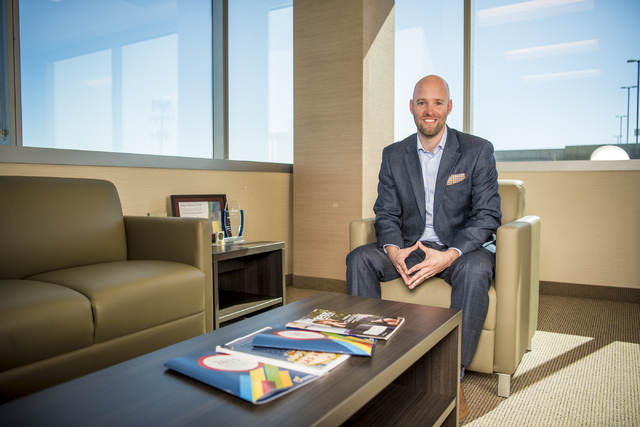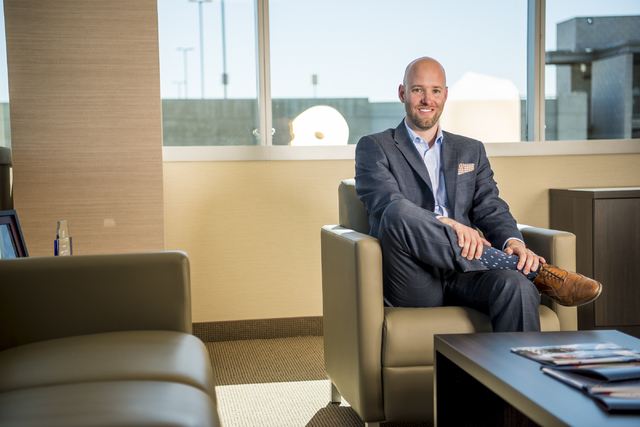



For the Las Vegas Global Economic Alliance, turning 60 isn’t a time for self-congratulatory marketing and ceremonial anniversary celebrations. It has been a time of expansion, from personnel resources to new partnerships and initiatives to ensure that LVGEA’s influence can last another 60 years.
“We are focused on creating meaningful and creative partnerships,” said Jonas R. Peterson, president and chief executive officer of LVGEA. “As long as we continue to do that we can maintain our status as a one-stop resource for our city’s businesses.”
That also includes small businesses, which have a pent-up demand to unitize more of LVGEA’s resources. Just this month, LVGEA has begun partnering with UNLV’s Small Business Development Center, including co-location at LVGEA’s new offices.
The partnership’s goal is to share and distribute information to local small businesses, including resources on capital, regulatory policies, workforce statistics and availability as well as tax and financial incentives. LVGEA is launching a conference about accessing capital later this year.
“We want to make this partnership as easy as possible,” Peterson said. “These are going to be seamless services and resources to the business community.”
Another new partnership LVGEA is developing is the highly anticipated Council of Chambers, a unique organization that caters to all of the many chambers of commerce in Las Vegas. This includes geographic, ethnic and cultural chambers of commerce. Peterson and LVGEA’s goal is to recruit the chief executive officer of each chamber to join the new council of chambers.
“We are excited about the Council of Chambers and offering our resources to them so they are well-positioned in this market,” Peterson said. “We want to connect the organizations, and add value where we can. The ability for all of us to share communications about projects, data and business prospects will help all that are involved.”
The constant theme of business collaboration is what has driven LVGEA to its fastest first-quarter start in organization history, measured by many metrics from new jobs to new member business and partnerships.
“We are fully committed to community development and economic development, strategies and tactics,” Peterson said.
Another tactic that showcases the fine balance between the two development strategies is the Biz Connect initiative that began last year. Biz Connect focuses on immediate and long-term business needs regarding capital. LVGEA plans to use shared partnerships and access to capital resources to create “an ecosystem with communication between the companies.”
As Biz Connect enters its second year, LVGEA is incorporating more online tools for business as well as distributing more surveys to identify the needs of its members. LVGEA wants to identify the issues that member companies are facing and make the proper adjustments for an even more efficient Biz Connect resource.
“Biz Connect is a business retention and expansion program that has resources to fit any industry,” Peterson said. “We are increasing access to literally thousands of businesses this year, making it even more relevant.”
Relevancy is at the heart of another resource LVGEA wants to capitalize on in 2016: Clark County’s Foreign Trade Zone. The FTZ is an underutilized program that benefits businesses that do all of their product manufacturing and assembly in Clark County, FTZ number 89.
LVGEA’s goal is to make sure key businesses that do a lot of importing and exporting are aware of FTZ benefits.
The long-term goal is to even add another foreign trade zone to the area so that businesses have a larger area to utilize to receive foreign trade zone benefits.
“We need to increase our level of outreach and marketing about our Foreign Trade Zone 89,” Peterson said. “This will allow us to be even more competitive and allow for more partnering within the region.”
To help with regional partnering, LVGEA has launched a community and economic research center, headed by Michael Gordon, a policy analyst with a doctorate from UNLV. The task of the research center is to dive deep into issues impacting the community or the economy and identify ways to build cohesive solutions and resources.
One issue that has been identified is a lack of industrial building inventory across Clark County. The imbalance between strong demand and a weak supply is costing the county and businesses millions of dollars every year. Imbalances like this are at the heart of why LVGEA is so deeply invested in the new community and economic research center.
“We will also use the research center to identify talent and identify the economic impact of key industries,” Peterson said. “The center will engage a lot of parties with two-way dialogue with other entities that have the same interest.”
There is already a lot of interest and engagement within LVGEA. It has the largest board of directors in Las Vegas with 44 members, a number that will expand to 50 this year. Recruitment has begun to identify and qualify the six new members.
“Our board has given a clear directive to build one of the most influential economic development organizations on the West Coast in three years,” Peterson said. “We have the largest corporate board of its kind in Nevada with very accomplished leaders across all industries and sectors, so we do not overlook any area.
“Our board has skin in the game, so they are willing participants, and everyone is full of energy because we are supporting each other and giving each other new ideas, resources and strategies that we can all share.”







